HNC/D Leadership and Management for Service Industries Report
VerifiedAdded on 2020/12/29
|10
|2539
|446
Report
AI Summary
This report examines leadership and management within the service industry, focusing on the case study of Hazev, Haz, and Tas restaurants. It begins by exploring classical management theories like scientific, bureaucratic, and administrative approaches and their application in enhancing productivity and efficiency. The report then delves into the role of leaders, various leadership styles (visionary, coaching, affiliative, democratic, and autocratic), and their impact on organizational culture. It further analyzes internal factors such as mission, leadership, communication, and organizational structure, as well as external factors including political, social, economic, and technological influences that affect management and leadership. The assessment covers current "hard and soft skills" and future management and leadership skills, such as tech management and flexibility. The report concludes by comparing and contrasting management and leadership styles across different service sectors, offering valuable insights for improved operational effectiveness and customer satisfaction.
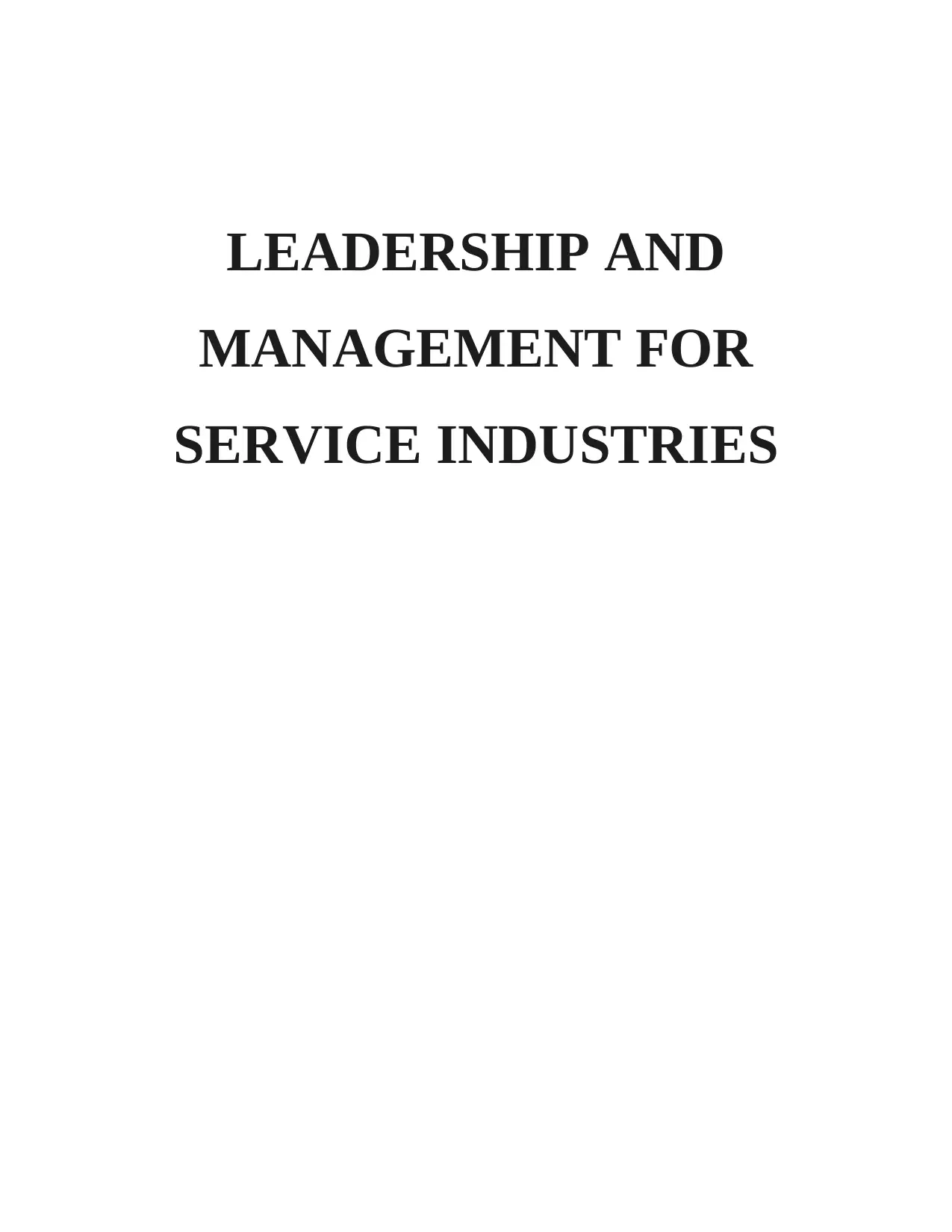
LEADERSHIP AND
MANAGEMENT FOR
SERVICE INDUSTRIES
MANAGEMENT FOR
SERVICE INDUSTRIES
Paraphrase This Document
Need a fresh take? Get an instant paraphrase of this document with our AI Paraphraser
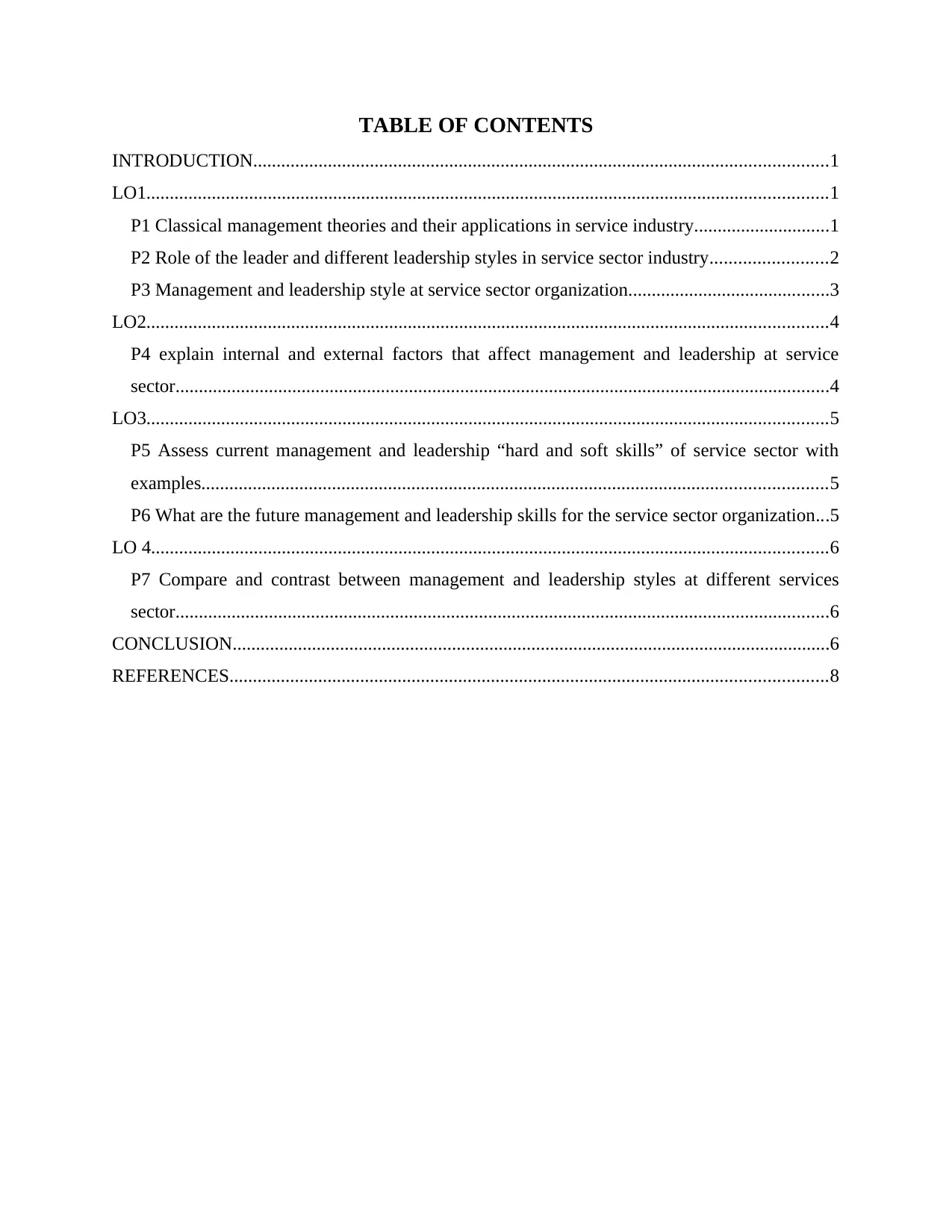
TABLE OF CONTENTS
INTRODUCTION...........................................................................................................................1
LO1..................................................................................................................................................1
P1 Classical management theories and their applications in service industry.............................1
P2 Role of the leader and different leadership styles in service sector industry.........................2
P3 Management and leadership style at service sector organization...........................................3
LO2..................................................................................................................................................4
P4 explain internal and external factors that affect management and leadership at service
sector............................................................................................................................................4
LO3..................................................................................................................................................5
P5 Assess current management and leadership “hard and soft skills” of service sector with
examples......................................................................................................................................5
P6 What are the future management and leadership skills for the service sector organization...5
LO 4.................................................................................................................................................6
P7 Compare and contrast between management and leadership styles at different services
sector............................................................................................................................................6
CONCLUSION................................................................................................................................6
REFERENCES................................................................................................................................8
INTRODUCTION...........................................................................................................................1
LO1..................................................................................................................................................1
P1 Classical management theories and their applications in service industry.............................1
P2 Role of the leader and different leadership styles in service sector industry.........................2
P3 Management and leadership style at service sector organization...........................................3
LO2..................................................................................................................................................4
P4 explain internal and external factors that affect management and leadership at service
sector............................................................................................................................................4
LO3..................................................................................................................................................5
P5 Assess current management and leadership “hard and soft skills” of service sector with
examples......................................................................................................................................5
P6 What are the future management and leadership skills for the service sector organization...5
LO 4.................................................................................................................................................6
P7 Compare and contrast between management and leadership styles at different services
sector............................................................................................................................................6
CONCLUSION................................................................................................................................6
REFERENCES................................................................................................................................8
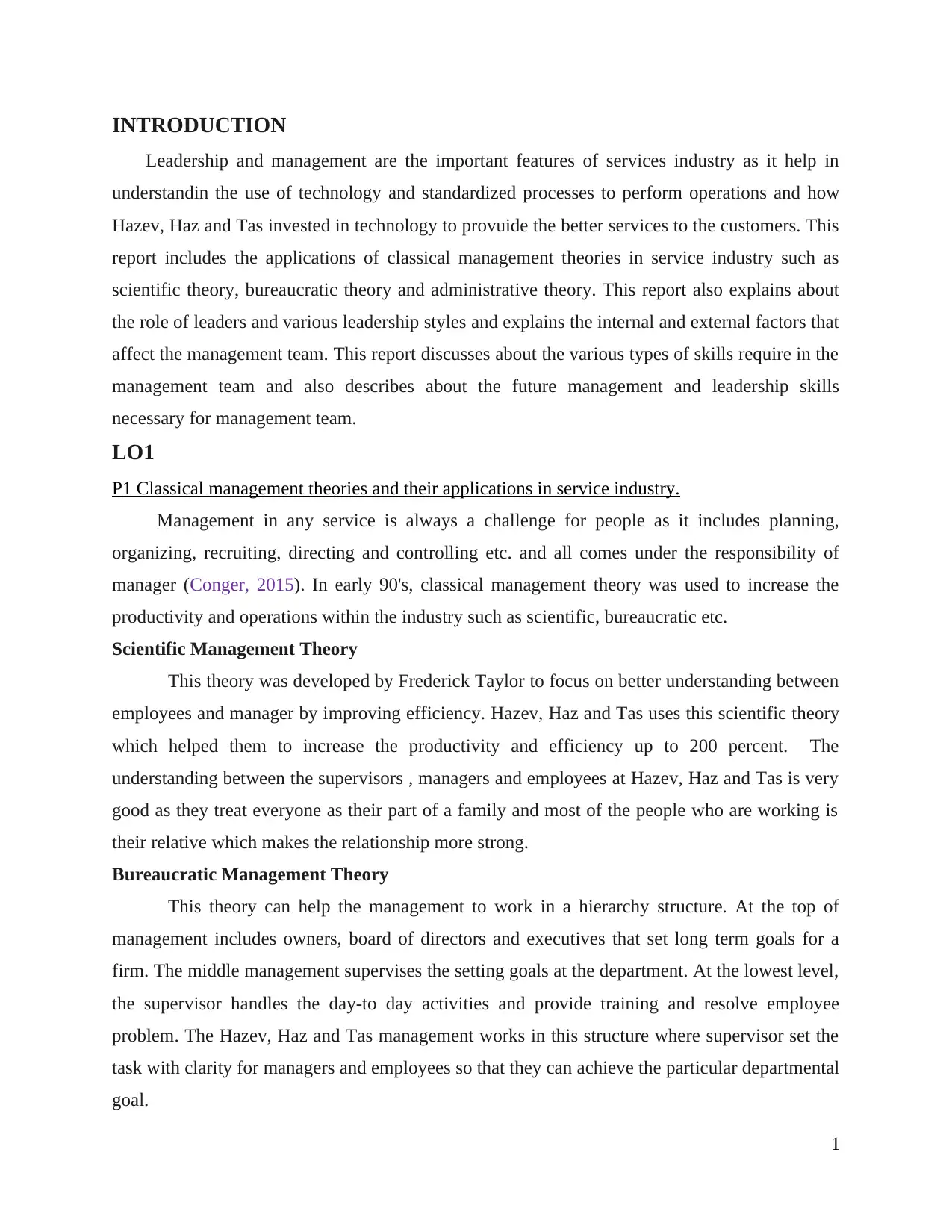
INTRODUCTION
Leadership and management are the important features of services industry as it help in
understandin the use of technology and standardized processes to perform operations and how
Hazev, Haz and Tas invested in technology to provuide the better services to the customers. This
report includes the applications of classical management theories in service industry such as
scientific theory, bureaucratic theory and administrative theory. This report also explains about
the role of leaders and various leadership styles and explains the internal and external factors that
affect the management team. This report discusses about the various types of skills require in the
management team and also describes about the future management and leadership skills
necessary for management team.
LO1
P1 Classical management theories and their applications in service industry.
Management in any service is always a challenge for people as it includes planning,
organizing, recruiting, directing and controlling etc. and all comes under the responsibility of
manager (Conger, 2015). In early 90's, classical management theory was used to increase the
productivity and operations within the industry such as scientific, bureaucratic etc.
Scientific Management Theory
This theory was developed by Frederick Taylor to focus on better understanding between
employees and manager by improving efficiency. Hazev, Haz and Tas uses this scientific theory
which helped them to increase the productivity and efficiency up to 200 percent. The
understanding between the supervisors , managers and employees at Hazev, Haz and Tas is very
good as they treat everyone as their part of a family and most of the people who are working is
their relative which makes the relationship more strong.
Bureaucratic Management Theory
This theory can help the management to work in a hierarchy structure. At the top of
management includes owners, board of directors and executives that set long term goals for a
firm. The middle management supervises the setting goals at the department. At the lowest level,
the supervisor handles the day-to day activities and provide training and resolve employee
problem. The Hazev, Haz and Tas management works in this structure where supervisor set the
task with clarity for managers and employees so that they can achieve the particular departmental
goal.
1
Leadership and management are the important features of services industry as it help in
understandin the use of technology and standardized processes to perform operations and how
Hazev, Haz and Tas invested in technology to provuide the better services to the customers. This
report includes the applications of classical management theories in service industry such as
scientific theory, bureaucratic theory and administrative theory. This report also explains about
the role of leaders and various leadership styles and explains the internal and external factors that
affect the management team. This report discusses about the various types of skills require in the
management team and also describes about the future management and leadership skills
necessary for management team.
LO1
P1 Classical management theories and their applications in service industry.
Management in any service is always a challenge for people as it includes planning,
organizing, recruiting, directing and controlling etc. and all comes under the responsibility of
manager (Conger, 2015). In early 90's, classical management theory was used to increase the
productivity and operations within the industry such as scientific, bureaucratic etc.
Scientific Management Theory
This theory was developed by Frederick Taylor to focus on better understanding between
employees and manager by improving efficiency. Hazev, Haz and Tas uses this scientific theory
which helped them to increase the productivity and efficiency up to 200 percent. The
understanding between the supervisors , managers and employees at Hazev, Haz and Tas is very
good as they treat everyone as their part of a family and most of the people who are working is
their relative which makes the relationship more strong.
Bureaucratic Management Theory
This theory can help the management to work in a hierarchy structure. At the top of
management includes owners, board of directors and executives that set long term goals for a
firm. The middle management supervises the setting goals at the department. At the lowest level,
the supervisor handles the day-to day activities and provide training and resolve employee
problem. The Hazev, Haz and Tas management works in this structure where supervisor set the
task with clarity for managers and employees so that they can achieve the particular departmental
goal.
1
⊘ This is a preview!⊘
Do you want full access?
Subscribe today to unlock all pages.

Trusted by 1+ million students worldwide
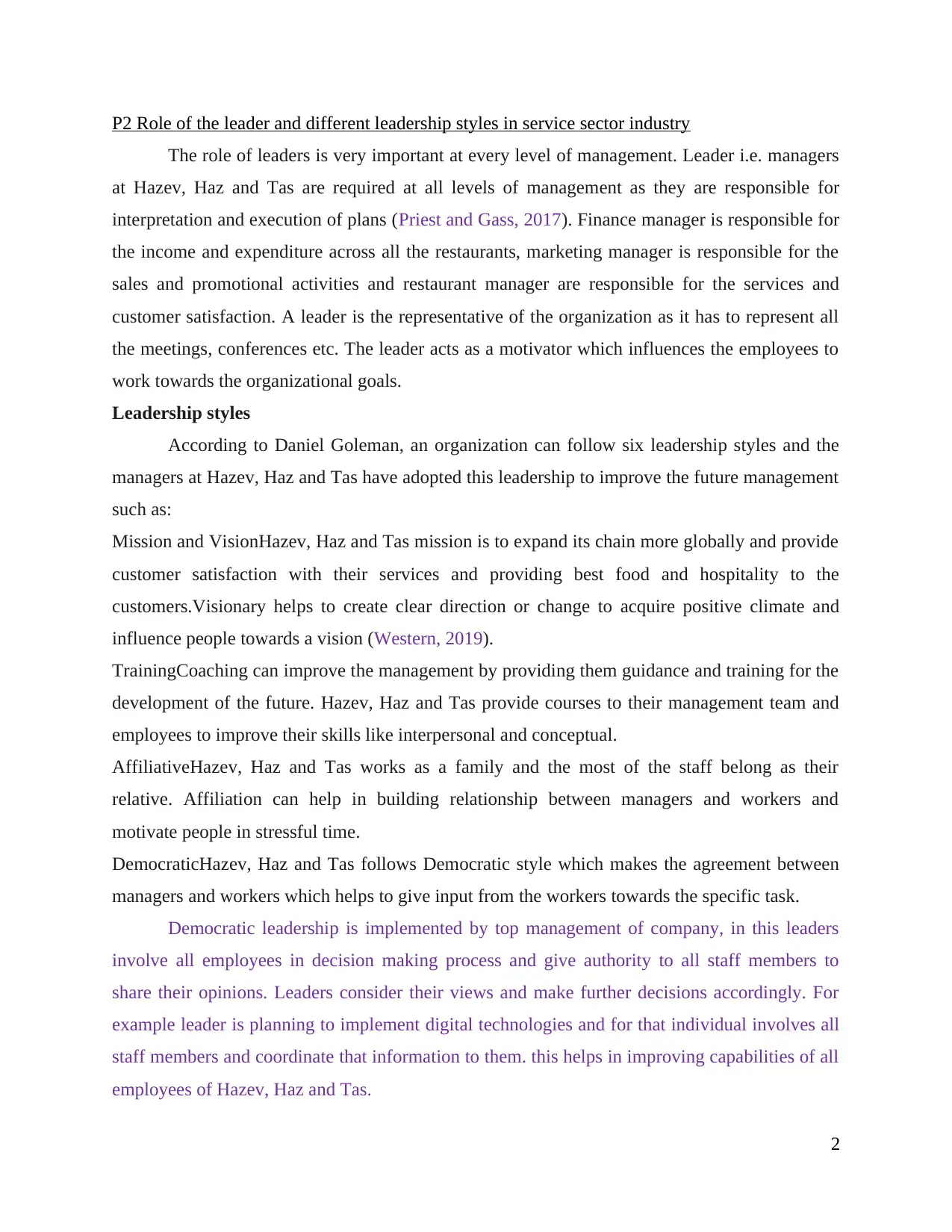
P2 Role of the leader and different leadership styles in service sector industry
The role of leaders is very important at every level of management. Leader i.e. managers
at Hazev, Haz and Tas are required at all levels of management as they are responsible for
interpretation and execution of plans (Priest and Gass, 2017). Finance manager is responsible for
the income and expenditure across all the restaurants, marketing manager is responsible for the
sales and promotional activities and restaurant manager are responsible for the services and
customer satisfaction. A leader is the representative of the organization as it has to represent all
the meetings, conferences etc. The leader acts as a motivator which influences the employees to
work towards the organizational goals.
Leadership styles
According to Daniel Goleman, an organization can follow six leadership styles and the
managers at Hazev, Haz and Tas have adopted this leadership to improve the future management
such as:
Mission and VisionHazev, Haz and Tas mission is to expand its chain more globally and provide
customer satisfaction with their services and providing best food and hospitality to the
customers.Visionary helps to create clear direction or change to acquire positive climate and
influence people towards a vision (Western, 2019).
TrainingCoaching can improve the management by providing them guidance and training for the
development of the future. Hazev, Haz and Tas provide courses to their management team and
employees to improve their skills like interpersonal and conceptual.
AffiliativeHazev, Haz and Tas works as a family and the most of the staff belong as their
relative. Affiliation can help in building relationship between managers and workers and
motivate people in stressful time.
DemocraticHazev, Haz and Tas follows Democratic style which makes the agreement between
managers and workers which helps to give input from the workers towards the specific task.
Democratic leadership is implemented by top management of company, in this leaders
involve all employees in decision making process and give authority to all staff members to
share their opinions. Leaders consider their views and make further decisions accordingly. For
example leader is planning to implement digital technologies and for that individual involves all
staff members and coordinate that information to them. this helps in improving capabilities of all
employees of Hazev, Haz and Tas.
2
The role of leaders is very important at every level of management. Leader i.e. managers
at Hazev, Haz and Tas are required at all levels of management as they are responsible for
interpretation and execution of plans (Priest and Gass, 2017). Finance manager is responsible for
the income and expenditure across all the restaurants, marketing manager is responsible for the
sales and promotional activities and restaurant manager are responsible for the services and
customer satisfaction. A leader is the representative of the organization as it has to represent all
the meetings, conferences etc. The leader acts as a motivator which influences the employees to
work towards the organizational goals.
Leadership styles
According to Daniel Goleman, an organization can follow six leadership styles and the
managers at Hazev, Haz and Tas have adopted this leadership to improve the future management
such as:
Mission and VisionHazev, Haz and Tas mission is to expand its chain more globally and provide
customer satisfaction with their services and providing best food and hospitality to the
customers.Visionary helps to create clear direction or change to acquire positive climate and
influence people towards a vision (Western, 2019).
TrainingCoaching can improve the management by providing them guidance and training for the
development of the future. Hazev, Haz and Tas provide courses to their management team and
employees to improve their skills like interpersonal and conceptual.
AffiliativeHazev, Haz and Tas works as a family and the most of the staff belong as their
relative. Affiliation can help in building relationship between managers and workers and
motivate people in stressful time.
DemocraticHazev, Haz and Tas follows Democratic style which makes the agreement between
managers and workers which helps to give input from the workers towards the specific task.
Democratic leadership is implemented by top management of company, in this leaders
involve all employees in decision making process and give authority to all staff members to
share their opinions. Leaders consider their views and make further decisions accordingly. For
example leader is planning to implement digital technologies and for that individual involves all
staff members and coordinate that information to them. this helps in improving capabilities of all
employees of Hazev, Haz and Tas.
2
Paraphrase This Document
Need a fresh take? Get an instant paraphrase of this document with our AI Paraphraser
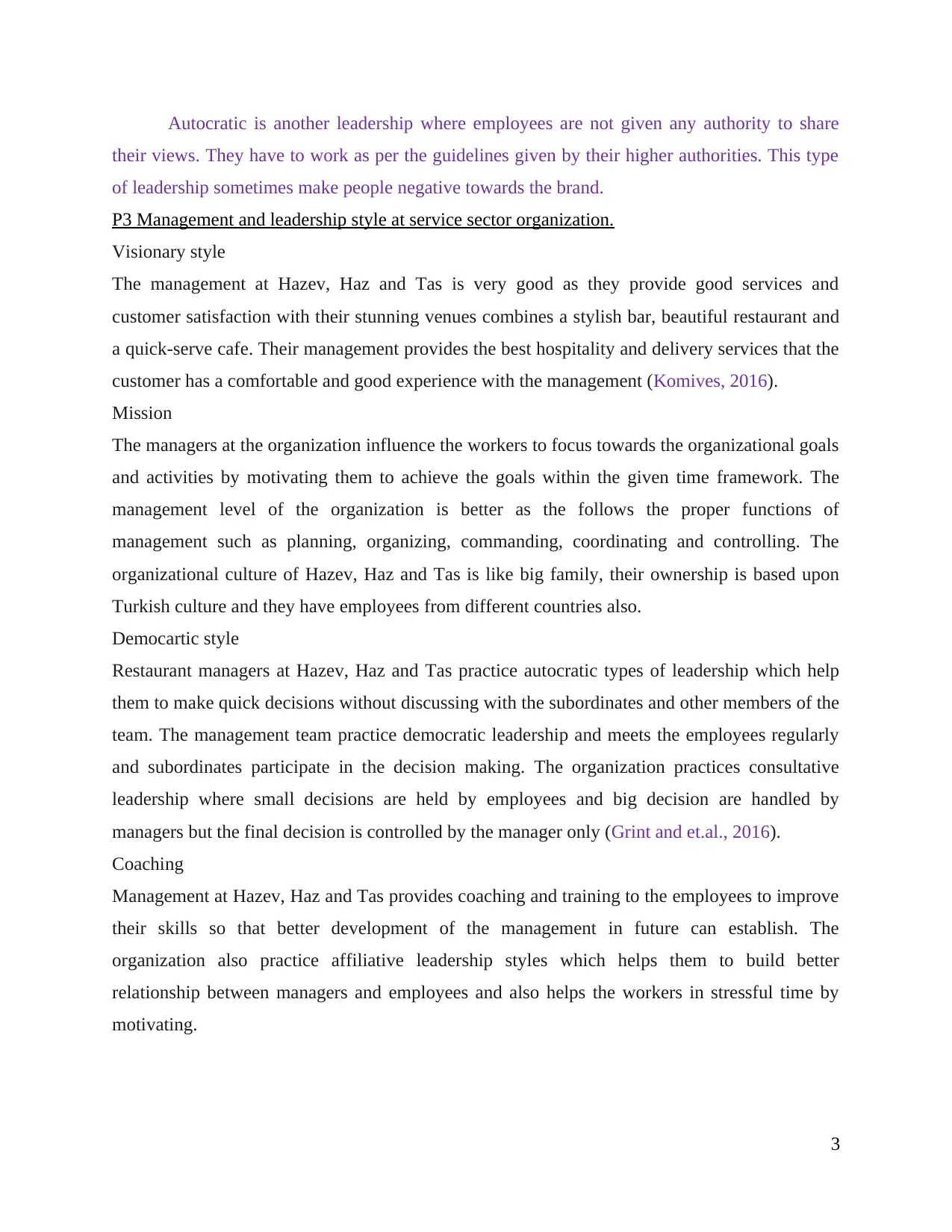
Autocratic is another leadership where employees are not given any authority to share
their views. They have to work as per the guidelines given by their higher authorities. This type
of leadership sometimes make people negative towards the brand.
P3 Management and leadership style at service sector organization.
Visionary style
The management at Hazev, Haz and Tas is very good as they provide good services and
customer satisfaction with their stunning venues combines a stylish bar, beautiful restaurant and
a quick-serve cafe. Their management provides the best hospitality and delivery services that the
customer has a comfortable and good experience with the management (Komives, 2016).
Mission
The managers at the organization influence the workers to focus towards the organizational goals
and activities by motivating them to achieve the goals within the given time framework. The
management level of the organization is better as the follows the proper functions of
management such as planning, organizing, commanding, coordinating and controlling. The
organizational culture of Hazev, Haz and Tas is like big family, their ownership is based upon
Turkish culture and they have employees from different countries also.
Democartic style
Restaurant managers at Hazev, Haz and Tas practice autocratic types of leadership which help
them to make quick decisions without discussing with the subordinates and other members of the
team. The management team practice democratic leadership and meets the employees regularly
and subordinates participate in the decision making. The organization practices consultative
leadership where small decisions are held by employees and big decision are handled by
managers but the final decision is controlled by the manager only (Grint and et.al., 2016).
Coaching
Management at Hazev, Haz and Tas provides coaching and training to the employees to improve
their skills so that better development of the management in future can establish. The
organization also practice affiliative leadership styles which helps them to build better
relationship between managers and employees and also helps the workers in stressful time by
motivating.
3
their views. They have to work as per the guidelines given by their higher authorities. This type
of leadership sometimes make people negative towards the brand.
P3 Management and leadership style at service sector organization.
Visionary style
The management at Hazev, Haz and Tas is very good as they provide good services and
customer satisfaction with their stunning venues combines a stylish bar, beautiful restaurant and
a quick-serve cafe. Their management provides the best hospitality and delivery services that the
customer has a comfortable and good experience with the management (Komives, 2016).
Mission
The managers at the organization influence the workers to focus towards the organizational goals
and activities by motivating them to achieve the goals within the given time framework. The
management level of the organization is better as the follows the proper functions of
management such as planning, organizing, commanding, coordinating and controlling. The
organizational culture of Hazev, Haz and Tas is like big family, their ownership is based upon
Turkish culture and they have employees from different countries also.
Democartic style
Restaurant managers at Hazev, Haz and Tas practice autocratic types of leadership which help
them to make quick decisions without discussing with the subordinates and other members of the
team. The management team practice democratic leadership and meets the employees regularly
and subordinates participate in the decision making. The organization practices consultative
leadership where small decisions are held by employees and big decision are handled by
managers but the final decision is controlled by the manager only (Grint and et.al., 2016).
Coaching
Management at Hazev, Haz and Tas provides coaching and training to the employees to improve
their skills so that better development of the management in future can establish. The
organization also practice affiliative leadership styles which helps them to build better
relationship between managers and employees and also helps the workers in stressful time by
motivating.
3
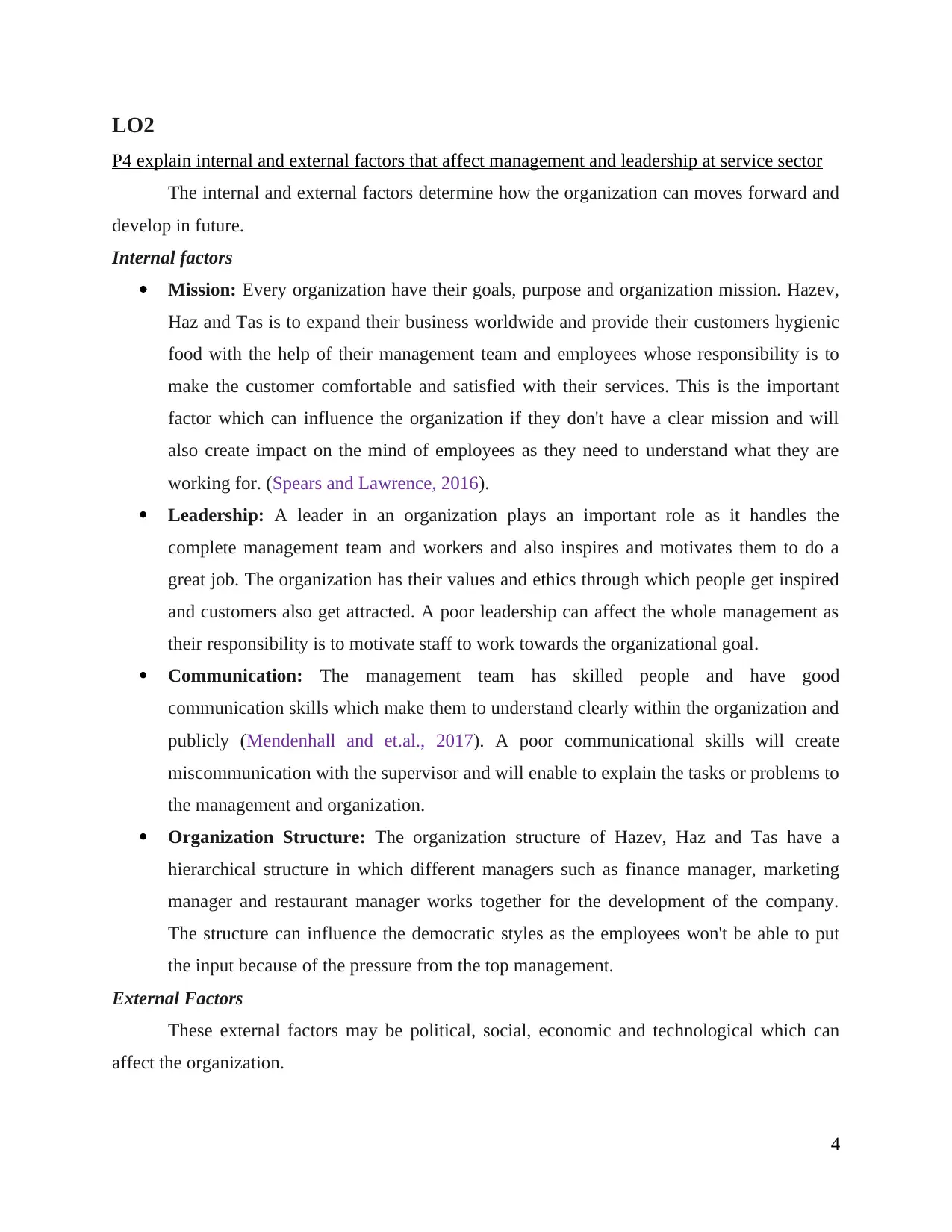
LO2
P4 explain internal and external factors that affect management and leadership at service sector
The internal and external factors determine how the organization can moves forward and
develop in future.
Internal factors
Mission: Every organization have their goals, purpose and organization mission. Hazev,
Haz and Tas is to expand their business worldwide and provide their customers hygienic
food with the help of their management team and employees whose responsibility is to
make the customer comfortable and satisfied with their services. This is the important
factor which can influence the organization if they don't have a clear mission and will
also create impact on the mind of employees as they need to understand what they are
working for. (Spears and Lawrence, 2016).
Leadership: A leader in an organization plays an important role as it handles the
complete management team and workers and also inspires and motivates them to do a
great job. The organization has their values and ethics through which people get inspired
and customers also get attracted. A poor leadership can affect the whole management as
their responsibility is to motivate staff to work towards the organizational goal.
Communication: The management team has skilled people and have good
communication skills which make them to understand clearly within the organization and
publicly (Mendenhall and et.al., 2017). A poor communicational skills will create
miscommunication with the supervisor and will enable to explain the tasks or problems to
the management and organization.
Organization Structure: The organization structure of Hazev, Haz and Tas have a
hierarchical structure in which different managers such as finance manager, marketing
manager and restaurant manager works together for the development of the company.
The structure can influence the democratic styles as the employees won't be able to put
the input because of the pressure from the top management.
External Factors
These external factors may be political, social, economic and technological which can
affect the organization.
4
P4 explain internal and external factors that affect management and leadership at service sector
The internal and external factors determine how the organization can moves forward and
develop in future.
Internal factors
Mission: Every organization have their goals, purpose and organization mission. Hazev,
Haz and Tas is to expand their business worldwide and provide their customers hygienic
food with the help of their management team and employees whose responsibility is to
make the customer comfortable and satisfied with their services. This is the important
factor which can influence the organization if they don't have a clear mission and will
also create impact on the mind of employees as they need to understand what they are
working for. (Spears and Lawrence, 2016).
Leadership: A leader in an organization plays an important role as it handles the
complete management team and workers and also inspires and motivates them to do a
great job. The organization has their values and ethics through which people get inspired
and customers also get attracted. A poor leadership can affect the whole management as
their responsibility is to motivate staff to work towards the organizational goal.
Communication: The management team has skilled people and have good
communication skills which make them to understand clearly within the organization and
publicly (Mendenhall and et.al., 2017). A poor communicational skills will create
miscommunication with the supervisor and will enable to explain the tasks or problems to
the management and organization.
Organization Structure: The organization structure of Hazev, Haz and Tas have a
hierarchical structure in which different managers such as finance manager, marketing
manager and restaurant manager works together for the development of the company.
The structure can influence the democratic styles as the employees won't be able to put
the input because of the pressure from the top management.
External Factors
These external factors may be political, social, economic and technological which can
affect the organization.
4
⊘ This is a preview!⊘
Do you want full access?
Subscribe today to unlock all pages.

Trusted by 1+ million students worldwide
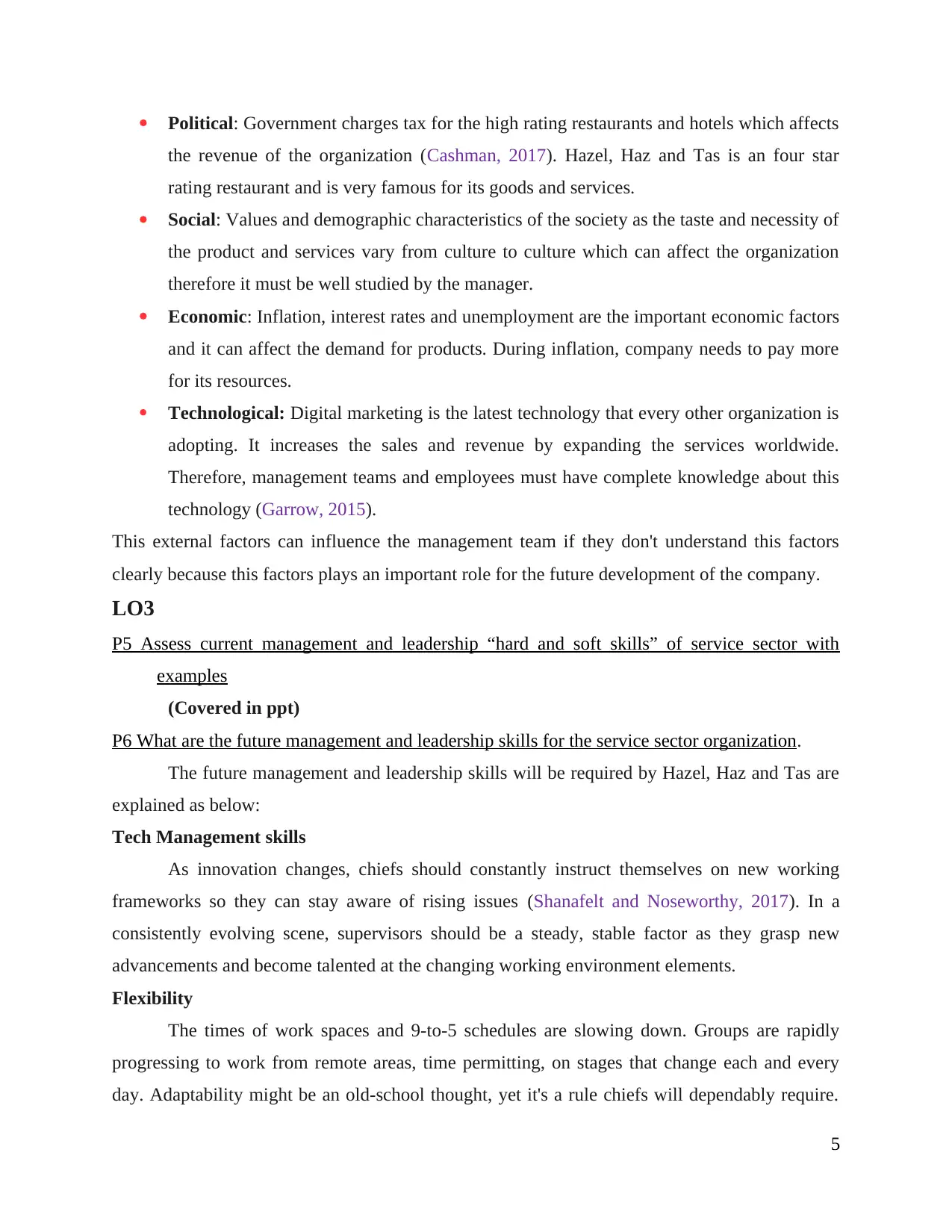
Political: Government charges tax for the high rating restaurants and hotels which affects
the revenue of the organization (Cashman, 2017). Hazel, Haz and Tas is an four star
rating restaurant and is very famous for its goods and services.
Social: Values and demographic characteristics of the society as the taste and necessity of
the product and services vary from culture to culture which can affect the organization
therefore it must be well studied by the manager.
Economic: Inflation, interest rates and unemployment are the important economic factors
and it can affect the demand for products. During inflation, company needs to pay more
for its resources.
Technological: Digital marketing is the latest technology that every other organization is
adopting. It increases the sales and revenue by expanding the services worldwide.
Therefore, management teams and employees must have complete knowledge about this
technology (Garrow, 2015).
This external factors can influence the management team if they don't understand this factors
clearly because this factors plays an important role for the future development of the company.
LO3
P5 Assess current management and leadership “hard and soft skills” of service sector with
examples
(Covered in ppt)
P6 What are the future management and leadership skills for the service sector organization.
The future management and leadership skills will be required by Hazel, Haz and Tas are
explained as below:
Tech Management skills
As innovation changes, chiefs should constantly instruct themselves on new working
frameworks so they can stay aware of rising issues (Shanafelt and Noseworthy, 2017). In a
consistently evolving scene, supervisors should be a steady, stable factor as they grasp new
advancements and become talented at the changing working environment elements.
Flexibility
The times of work spaces and 9-to-5 schedules are slowing down. Groups are rapidly
progressing to work from remote areas, time permitting, on stages that change each and every
day. Adaptability might be an old-school thought, yet it's a rule chiefs will dependably require.
5
the revenue of the organization (Cashman, 2017). Hazel, Haz and Tas is an four star
rating restaurant and is very famous for its goods and services.
Social: Values and demographic characteristics of the society as the taste and necessity of
the product and services vary from culture to culture which can affect the organization
therefore it must be well studied by the manager.
Economic: Inflation, interest rates and unemployment are the important economic factors
and it can affect the demand for products. During inflation, company needs to pay more
for its resources.
Technological: Digital marketing is the latest technology that every other organization is
adopting. It increases the sales and revenue by expanding the services worldwide.
Therefore, management teams and employees must have complete knowledge about this
technology (Garrow, 2015).
This external factors can influence the management team if they don't understand this factors
clearly because this factors plays an important role for the future development of the company.
LO3
P5 Assess current management and leadership “hard and soft skills” of service sector with
examples
(Covered in ppt)
P6 What are the future management and leadership skills for the service sector organization.
The future management and leadership skills will be required by Hazel, Haz and Tas are
explained as below:
Tech Management skills
As innovation changes, chiefs should constantly instruct themselves on new working
frameworks so they can stay aware of rising issues (Shanafelt and Noseworthy, 2017). In a
consistently evolving scene, supervisors should be a steady, stable factor as they grasp new
advancements and become talented at the changing working environment elements.
Flexibility
The times of work spaces and 9-to-5 schedules are slowing down. Groups are rapidly
progressing to work from remote areas, time permitting, on stages that change each and every
day. Adaptability might be an old-school thought, yet it's a rule chiefs will dependably require.
5
Paraphrase This Document
Need a fresh take? Get an instant paraphrase of this document with our AI Paraphraser

Adjusting to the changing innovation and millennial-made societies keep on keeping pioneers
crisp and powerful.
Soft Skills Assessments
Similarly as all representatives will require specialized abilities, delicate aptitudes will be
a prime character quality for supervisors to create themselves so they can evaluate it in future
contracts (Yahaya and Ebrahim, 2016). This implies aptitudes like tuning in, effective
correspondence, uplifting mentalities, tolerating criticism, and extraordinary time the executives
are required. The Hazev, Haz and Tas developed the above skills to improve the management of
the organization so that more customers can attract with their services. The other company who
is developing this changes is Travelodge who is working on these skills to be given to their
workforce.
LO 4
P7 Compare and contrast between management and leadership styles at different services sector.
(covered in ppt)
CONCLUSION
From the above report I had been summarized that by using the classical management
theories helped the organization Hazev, Haz and Tas to increase the productivity. This report
also highlighted the role of leaders and leadership styles they follow. This report gave the brief
description about the factors that can affect the management team and also highlighted the skills
required for the management team to succeed and develop the company in the future. It also
highlighted the future management and leadership skills require by the organization.
6
crisp and powerful.
Soft Skills Assessments
Similarly as all representatives will require specialized abilities, delicate aptitudes will be
a prime character quality for supervisors to create themselves so they can evaluate it in future
contracts (Yahaya and Ebrahim, 2016). This implies aptitudes like tuning in, effective
correspondence, uplifting mentalities, tolerating criticism, and extraordinary time the executives
are required. The Hazev, Haz and Tas developed the above skills to improve the management of
the organization so that more customers can attract with their services. The other company who
is developing this changes is Travelodge who is working on these skills to be given to their
workforce.
LO 4
P7 Compare and contrast between management and leadership styles at different services sector.
(covered in ppt)
CONCLUSION
From the above report I had been summarized that by using the classical management
theories helped the organization Hazev, Haz and Tas to increase the productivity. This report
also highlighted the role of leaders and leadership styles they follow. This report gave the brief
description about the factors that can affect the management team and also highlighted the skills
required for the management team to succeed and develop the company in the future. It also
highlighted the future management and leadership skills require by the organization.
6

7
⊘ This is a preview!⊘
Do you want full access?
Subscribe today to unlock all pages.

Trusted by 1+ million students worldwide
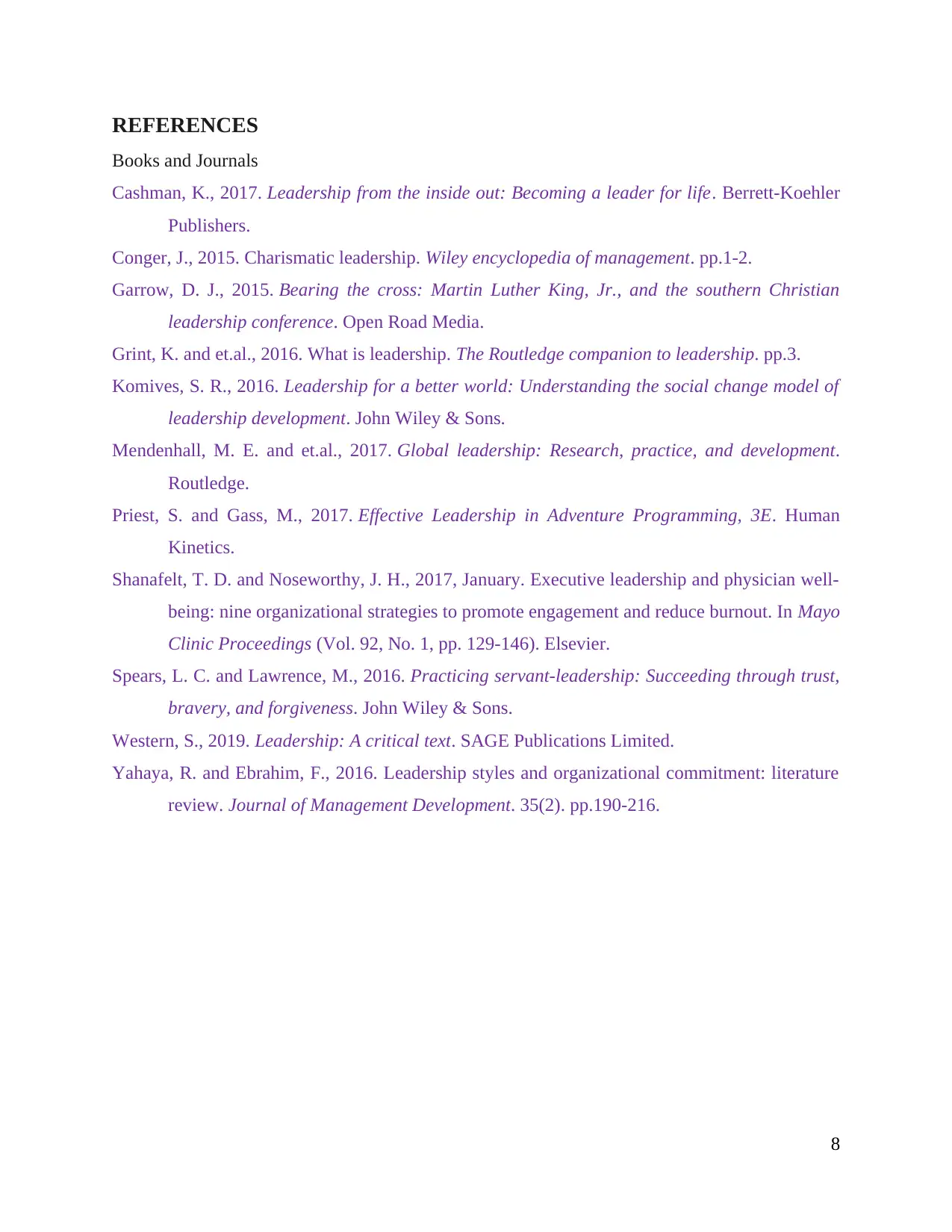
REFERENCES
Books and Journals
Cashman, K., 2017. Leadership from the inside out: Becoming a leader for life. Berrett-Koehler
Publishers.
Conger, J., 2015. Charismatic leadership. Wiley encyclopedia of management. pp.1-2.
Garrow, D. J., 2015. Bearing the cross: Martin Luther King, Jr., and the southern Christian
leadership conference. Open Road Media.
Grint, K. and et.al., 2016. What is leadership. The Routledge companion to leadership. pp.3.
Komives, S. R., 2016. Leadership for a better world: Understanding the social change model of
leadership development. John Wiley & Sons.
Mendenhall, M. E. and et.al., 2017. Global leadership: Research, practice, and development.
Routledge.
Priest, S. and Gass, M., 2017. Effective Leadership in Adventure Programming, 3E. Human
Kinetics.
Shanafelt, T. D. and Noseworthy, J. H., 2017, January. Executive leadership and physician well-
being: nine organizational strategies to promote engagement and reduce burnout. In Mayo
Clinic Proceedings (Vol. 92, No. 1, pp. 129-146). Elsevier.
Spears, L. C. and Lawrence, M., 2016. Practicing servant-leadership: Succeeding through trust,
bravery, and forgiveness. John Wiley & Sons.
Western, S., 2019. Leadership: A critical text. SAGE Publications Limited.
Yahaya, R. and Ebrahim, F., 2016. Leadership styles and organizational commitment: literature
review. Journal of Management Development. 35(2). pp.190-216.
8
Books and Journals
Cashman, K., 2017. Leadership from the inside out: Becoming a leader for life. Berrett-Koehler
Publishers.
Conger, J., 2015. Charismatic leadership. Wiley encyclopedia of management. pp.1-2.
Garrow, D. J., 2015. Bearing the cross: Martin Luther King, Jr., and the southern Christian
leadership conference. Open Road Media.
Grint, K. and et.al., 2016. What is leadership. The Routledge companion to leadership. pp.3.
Komives, S. R., 2016. Leadership for a better world: Understanding the social change model of
leadership development. John Wiley & Sons.
Mendenhall, M. E. and et.al., 2017. Global leadership: Research, practice, and development.
Routledge.
Priest, S. and Gass, M., 2017. Effective Leadership in Adventure Programming, 3E. Human
Kinetics.
Shanafelt, T. D. and Noseworthy, J. H., 2017, January. Executive leadership and physician well-
being: nine organizational strategies to promote engagement and reduce burnout. In Mayo
Clinic Proceedings (Vol. 92, No. 1, pp. 129-146). Elsevier.
Spears, L. C. and Lawrence, M., 2016. Practicing servant-leadership: Succeeding through trust,
bravery, and forgiveness. John Wiley & Sons.
Western, S., 2019. Leadership: A critical text. SAGE Publications Limited.
Yahaya, R. and Ebrahim, F., 2016. Leadership styles and organizational commitment: literature
review. Journal of Management Development. 35(2). pp.190-216.
8
1 out of 10
Related Documents
Your All-in-One AI-Powered Toolkit for Academic Success.
+13062052269
info@desklib.com
Available 24*7 on WhatsApp / Email
![[object Object]](/_next/static/media/star-bottom.7253800d.svg)
Unlock your academic potential
Copyright © 2020–2025 A2Z Services. All Rights Reserved. Developed and managed by ZUCOL.





